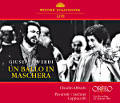ORFEO International – Reviews
Important Releases Briefly Introduced
February 2016
ORFEO 2 CD C 907 162 I
Giuseppe Verdi: Un ballo in maschera
Luciano Pavarotti’s repertoire comprised only a few roles, but his performances and recordings of them wrote and rewrote history. This was the case in 1970 as Nemorino (in L’elisir d’amore) alongside Joan Sutherland and in 1972 as Rodolfo (in La Bohème) under Karajan, with Mirella Freni als Mimí. 
C 907 162 IBut while Pavarotti’s Riccardo in Verdi’s Un ballo in maschera in his studio recording of 1983 is given pride of place because of its surface brilliance (not least thanks to Georg Solti on the podium), in his live TV broadcast of the same role three years later under Claudio Abbado he offers a striking sense of musical and dramatic immediacy. In this recording of that broadcast from the Vienna State Opera, we can hear a performance both highly nuanced and possessed of an immense radiance, from his very first “Amici mei” to his touching death scene.
Pavarotti had given his Vienna debut already in 1963 at the age of 27. He returned to sing there some 50 times in his landmark roles from Nemorino to Cavaradossi. What is astonishing time and again about Pavarotti is his unmistakeably beautiful, brilliant timbre. It even prompted the leading music critic Jürgen Kesting – who was otherwise so critical – to entitle his chapter on Pavarotti “Vocal eroticism” in his book on the great singers. After the famous canzona in the first act of this recording (“Di’ tu se fedele il flutto m’aspetta”), the audience of the Vienna State Opera justifiably burst into a storm of applause (and not for the last time either).
As in the studio recording with Pavarotti and Solti, the role of Amelia was sung by Margaret Price on the opening night of this production. In the second performance, the then 25-year-old Gabriele Lechner had to stand in for her – and she did so not just with an overwhelming, fiery, youthful vigour, but also with astonishing luminosity and conviction, despite her occasional (understandable) nerves. Just listen to the opening of the second act when Amelia waits fearfully for her beloved Riccardo alone at night – and then finally meets him. It’s rare to experience such a truthful performance as this. But the Russian mezzosoprano Ludmila Semtschuk as the fortune-teller Ulrica is also beguiling with her passion and profound depth.
Piero Cappuccilli had been well known to the Vienna audience for decades. He too is unmistakeable in his timbre and his art of musical characterisation. Like many famous Verdi baritones he was not free of vanity, but this has no adverse impact on his performance as the jealous husband of Amelia and the friend of Riccardo.
Claudio Abbado had been the new music director of the State Opera since the autumn of 1986. He had given his highly successful debut there just two years earlier. In the years up to 1991 he left his mark on all the musical events of the Vienna State Opera: on the performances in the house on the Ringstrasse, on co-productions at the Theater an der Wien, and also on guest performances outside the State Opera. As ever – and not just with Verdi – Abbado is convincing here in his insistence on a lean, sinewy, tense performance from the Vienna Philharmonic, and this is wholly in the interests of the musical drama. He is also a constant inspiration in how he accompanies the singers.
top |